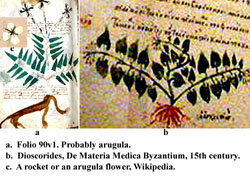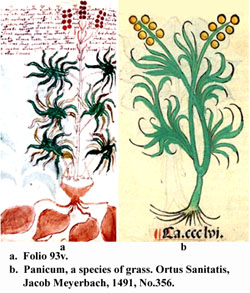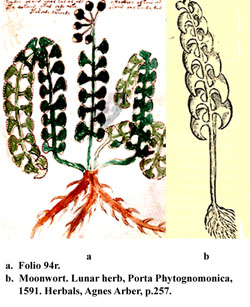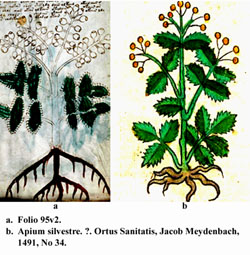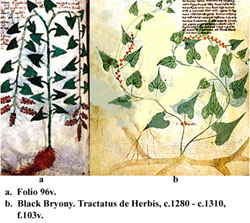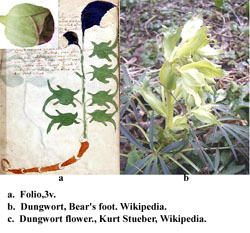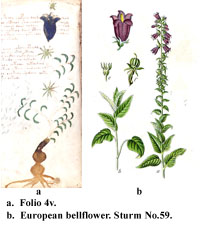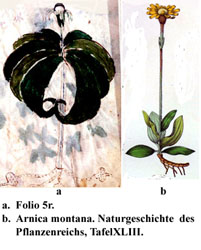The Voynich Botanical Plants
Folio 90v1. Arugula / Rocket (Eruca vesicaria). This plant is a member of the cabbage family. The early Romans used it in a mixed salad. It is considered to be an excellent stimulant and aphrodisiac, so it was considered prudent to mix it with lettuce which has the opposite effect. In the Middle ages monasteries were forbidden to grow arugula in their gardens. (1) (B)
Folio 93v. Panicum is switch grass. It does not resemble either of these two illustrations. (B)
Folio 94r. Moonwort or Moonfern (Botrychium lunaria). It is a small fern with fleshy roots. Its fronds are pinnate with 3 to 8 pairs of rounded leaves and a fertile spike that is completely covered, when ripe with brown spores. Legends claim that it can raise the dead, open locks and unshoe horses that tread on it. This folio was identified by Dana Scot. (1) (B)
Folio 95v2. No plant today has the name Apium silvestre. Apium would imply that it is a member of the celery family which is most unlikely. (B)
Folio 96r. Black hellebore (Helleborus niger) is a member of the ranunculaceae family and is therefore poisonous. In the Middle Ages people strew hellebore flowers on the floor to drive out evil influences. These same people believed that witches employed the herb in their spells and that sorcerers tossed the powdered herb in the air to make themselves invisible (1). Dioscorides describes hellebore as a purgative that is “good for ye Epileptical, Melancholicall, Frantic, Arthritical, Paralyticall.” The Grete Herball claims is will “cure gout, scruff of the head and scabies.” (2) (B)
Folio 96v. Black Byrony (Tamus communis) is a species of flowering plant in the yam family. The fleshy black root is very poisonous and should not be used to induce vomiting. It is used topically to reduce bruising, strains, and the pain of gout and arthritis by stimulating the nerve endings of the skin with needle–like crystals (1). Black byrony is a dangerous irritant poison. It is a powerful diuretic and was once used as a remedy for gravel. An overdose would result in a painful death. (4) (B)
Folio 3v. Dungwort / Bear’s foot (Helleborus foetidus) is a small, herbaceous shrub native to Western Europe. It has a thick, succulent stem; palmate compound leaves; drooping green, cup-shaped flowers; and short rhizomes for roots. All parts of the plant are poisonous. The leaves emit a bad smell when crushed. (C)
Folio 4v. European bellflower (Campanula). This genus contains over 500 species distributed across temperate regions of the Northern Hemisphere. One species, rampion, is grown for its spinach-like leaves and radish-like roots. There is an Italian tradition that the possession of a rampion excites quarrels among children. The story of Rapunzel is related to the theft of rampions from a magician’s garden. (C)
Folio 5r. Wolf's bane (Arnica montana) is a European flowering plant with large, yellow, daisy-like flowers. Tincture of Arnica has been used for external application to sprains, bruises, and wounds, and on chilblains when the skin is unbroken. Repeated applications may produce severe inflammation. Due to its toxic properties it is seldom used internally. (C)
Folio 7r. Bog stichwort / bog chickweed (Stellaria alsine). Some species of stellaria can be used as a leaf vegetable, often in salads. (C)
